Visitors to Fort Worden might have noted the ongoing fruits of its latest windfall, even if it made their paths through the state park slightly less convenient.
Fort Worden was recently awarded …
This item is available in full to subscribers.
We have recently launched a new and improved website. To continue reading, you will need to either log into your subscriber account, or purchase a new subscription.
If you had an active account on our previous website, then you have an account here. Simply reset your password to regain access to your account.
If you did not have an account on our previous website, but are a current print subscriber, click here to set up your website account.
Otherwise, click here to view your options for subscribing.
* Having trouble? Call our circulation department at 360-385-2900, or email our support.
Please log in to continue |
|
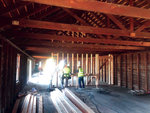
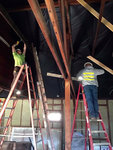
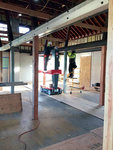
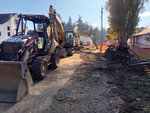
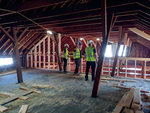
Visitors to Fort Worden might have noted the ongoing fruits of its latest windfall, even if it made their paths through the state park slightly less convenient.
Fort Worden was recently awarded $500,000 by the National Park Service to rehabilitate the historic Quartermaster Storehouse, or Building 305, as part of the $13.4 million Makers Square capital project.
Construction on the first phase of this project began in the summer of this year, and is slated to wrap up by the summer of next year, which is why parts of the usually public area are fenced off.
While this has required some minor inconveniences to visitors of Makers Square’s partner programs, it also represents significant progress toward the ultimate aim of the project, especially since more than $11.6 million, or 87% of the campaign goal, has been secured through federal and state funding sources and philanthropic gifts.
“We’re honored to be included among such a prestigious list of historic properties and collections,” said Dave Robison, executive director of the Fort Worden Foundation, which received the grant. “For more than a century, Fort Worden has been recognized as a site of cultural and historic significance, and we are privileged to be a part of the innovative partnership preserving this magnificent place for future generations.”
Makers Square is one of 41 projects in 23 states to be awarded a collective total of $12.6 million in matching grants through the “Save America’s Treasures” program, which represents a partnership between the National Park Service, the Institute of Museum and Library Services, the National Endowment for the Arts and the National Endowment for the Humanities.
The Fort Worden Foundation was additionally one of only two Washington State finalists, among the eight West Coast projects selected for funding.
U.S. Secretary of the Interior David Bernhardt pointed out that this $12.6 million in nationwide funding allows the leveraging of more than $22 million in private and public investment for preservation and conservation projects, “without spending taxpayers’ money.”
Constructed in the 1900s, Fort Worden is a designated National Historic Landmark that’s listed on both the National Register of Historic Places and the Washington Heritage Register, and Robison singled out Building 305 as “one of the most historically significant buildings” on the Fort Worden campus.
“Preservation of its key historic features, and its adaptive reuse as an arts and education center, will ensure that it remains a public asset for the next 100 years,” Robison said.
Constructed in 1904, Building 305 once served as the Quartermaster Storehouse, making it critical to supporting the operations of both Fort Worden and its garrison, but today, its utilitarian design has been touted by the Fort Worden Foundation as “well-suited” for being repurposed into an arts and education center.
The planned renovation of Building 305 is expected to yield more than 15,000 square feet of new space, with a prospective layout as follows:
• Main floor: Two classrooms, two large studios, one extended gallery space and one reception area.
• Basement: The new home of nonprofit community radio station KPTZ 91.9 FM, complete with modern recording and broadcast studios.
• Second floor: Flexible spaces for artists, nonprofit organizations and creative businesses that add to the vitality of Fort Worden through artist residencies, classes, exhibitions and workshops.
“Aspiring and master artists, craftsmen and makers will find a year-round community in which they can create, collaborate, educate and connect with new audiences,” said Megan Claflin, grants and public relations manager for the Fort Worden Public Development Authority.
Robison expressed the belief that the Makers Square project will “impact the artistic, cultural and economic factors that enhance the visibility” of Fort Worden, which “directly contributes to Port Townsend’s identity as an arts community.”
The first phase of the Makers Square project consists of the rehabilitation and repurposing of historic buildings 305, 308 and 324 to provide 25,000 square feet of new space designed to support multidisciplinary arts, culture and education programming, as well as to catch up on deferred maintenance, install a seismic retrofit and upgrade its utility, sewer, water and electrical services.
This will come complete with ADA-compliant bathrooms, ramps and an elevator.
Buildings 308 and 324 were previously used as storage warehouses, but the renovated Building 308 will provide more than 2,500 square feet divided into two large studios, while Building 324 will provide more than 3,500 square feet divided into four studios, plus an additional gallery space.
The second phase of construction is set to begin when the capital campaign is complete, and is slated to focus on balancing the pedestrian and vehicle traffic surrounding the facilities, and to build “visual and physical connections” between the creative spaces and the public.
“Arts and culture are powerful tools for engaging audiences around socioeconomic topics and supporting transformative learning,” Robison said. “By providing spaces in which ideas can incubate and evolve, where risks can be taken, and where imagination can thrive, we aspire to generate new opportunities for creativity on the Olympic Peninsula and beyond.”
In the meantime, Claflin encouraged those who plan on visiting partner programs on site to contact the program managers in advance, to confirm details such as the best routes to their programs.
“Guests who are visiting programs such as the Port Townsend School of the Arts or School of Woodworking can use the USO parking next to Taps at the Guardhouse, or the parking next to the Madrona MindBody Institute,” Claflin said. “But they are not allowed within the fenced-off construction area.”